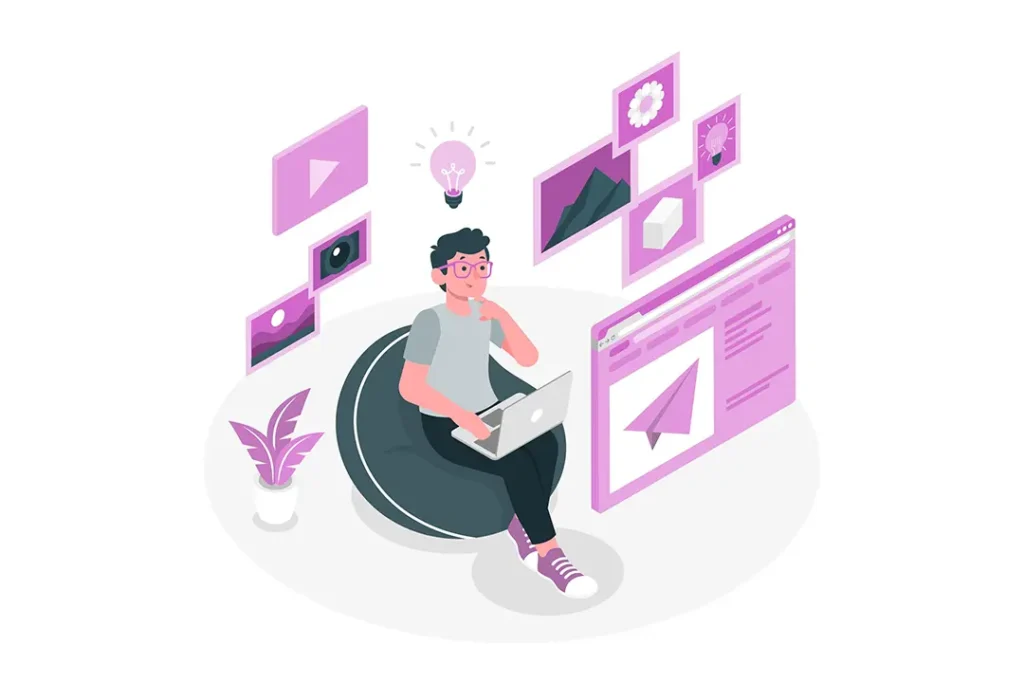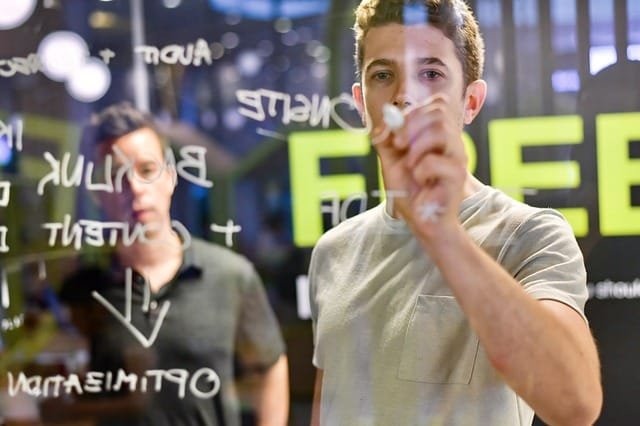(This Article has been revised, edited and added to, by Poulomi Chakraborty.)
In the vast and competitive realm of digital healthcare, the drive to constantly produce new content can be overwhelming. Yet, nestled within the archives of websites, blogs, and publications lies a goldmine of existing content, often overlooked, but ripe for repurposing. Repurposing content isn’t just a strategic move to save time or effort—it’s a powerful tool to bolster SEO, amplify reach, and enhance engagement without reinventing the wheel. For healthcare websites, where accuracy and trustworthiness are paramount, repurposing offers an opportunity to spotlight tried-and-true content in refreshing new ways. Join us as we unravel the art and strategy of repurposing content specifically tailored for healthcare websites, and why it’s the elixir your SEO strategy might just need.
Why Repurpose? The Unspoken Potential

Before diving into the ‘how’, it’s crucial to understand the ‘why’ behind repurposing content, especially in the healthcare context.
- Extended Shelf Life: Healthcare information, research, and advice often remain relevant long after initial publication. Repurposing breathes new life into such content, ensuring that valuable insights continue to serve and educate audiences.
- Boosting SEO: Google and other search engines love fresh content. Updating and reformatting existing pieces signal that your website is active and up-to-date, bolstering its SEO standing.
- Reach New Audiences: The way an individual consumes a blog post might differ from a podcast or an infographic. Repurposing allows healthcare sites to cater to varied audience preferences, broadening reach and impact.
Maximizing Resource Efficiency
In the competitive digital healthcare landscape, startups often operate with limited resources, including time, budget, and manpower. Repurposing content emerges as a strategic maneuver to amplify your message without the need for significant additional resources. By leveraging existing high-quality content, startups can maintain a consistent content output, crucial for building brand authority and trustworthiness. This approach not only optimizes your existing resources but also ensures your team can focus on innovation and other critical areas of business development.
Enhancing SEO Through Diverse Content Formats
Strategic Content Diversification
Search engines prioritize websites that offer a rich mix of content types. By transforming a single piece of content into multiple formats—such as videos, infographics, and podcasts—startups can cater to different user preferences and search engine criteria. This strategic diversification extends the reach of your content across various platforms, increasing visibility and driving traffic back to your site. Moreover, repurposed content can target a broader array of keywords, including long-tail queries, further enhancing your SEO efforts.
Building Domain Authority
Consistently repurposing and updating content signals to search engines that your website is a current and authoritative source in the healthcare domain. Over time, this can significantly improve your website’s domain authority, a critical factor in search rankings. By systematically revisiting and enriching your content, you not only make it more relevant to your audience but also strengthen your website’s standing in the competitive digital space.
Fostering Audience Engagement and Loyalty
Creating Touchpoints with Your Audience
Repurposed content allows multiple opportunities to engage with your audience through different mediums and platforms. Each format, be it a blog post, a webinar, or an interactive quiz, serves as a unique touchpoint, enhancing audience engagement. These varied interactions can deepen the relationship between your brand and your audience, fostering loyalty and trust. In the healthcare sector, where the decision-making process is often prolonged and informed, establishing such connections can be pivotal to conversion and retention.
Leveraging Social Proof
Repurposing content into formats that encourage user interaction and sharing, such as infographics and videos, can significantly amplify your reach through social proof. When users share your content, they not only extend its reach but also endorse your brand to their networks. This form of social proof can be invaluable for startups looking to establish their credibility and attract a broader audience.
Accelerating Thought Leadership
Establishing your startup as a thought leader in the digital healthcare space requires demonstrating expertise, insight, and a forward-thinking approach. Repurposing content strategically can help you achieve this by enabling you to explore various facets of a topic, present data in new and engaging ways, and consistently contribute valuable information to your field. By positioning your brand as a go-to resource for healthcare information, you can attract partnerships, media opportunities, and client trust—all of which are crucial for growth and success.
A Strategic Imperative
For healthcare startups, repurposing content is not just a tactical choice; it’s a strategic imperative. It allows for efficient use of resources, enhances SEO, fosters audience engagement, and accelerates the journey towards thought leadership. By embedding content repurposing into your digital marketing strategy, you can navigate the complexities of the healthcare sector more effectively, establishing a strong, authoritative presence in an increasingly crowded digital space.
Strategies for Effective Repurposing

Simply rehashing old content won’t cut it. Effective repurposing requires strategic thought, especially when the content revolves around sensitive topics like health.
- Update and Refresh: Begin by updating any outdated statistics, references, or findings. In the ever-evolving field of healthcare, staying current is crucial.
- Identify Evergreen Content: Focus on content that holds long-term relevance. For instance, an article on the “Basics of Cardiac Health” might be more evergreen than a piece on a specific, time-bound medical conference.
- Segment and Specialize: A comprehensive guide on “Healthy Eating” can be segmented into specialized posts like “Nutrition for Cardiac Health”, “Balanced Diets for Diabetics”, or “Vitamins Essential for Bone Health”.
Cultivating a Repurposing Mindset
Successful repurposing starts with a shift in perspective—viewing content not as a one-off effort but as a living entity within a broader ecosystem. For healthcare startups, this means planning content creation with repurposing in mind. It involves considering from the outset how a piece can be adapted, expanded, or reimagined across various formats and platforms. This proactive approach ensures that every piece of content created has multiple potentials for future use, maximizing the return on every content investment.
Strategic Content Auditing
Periodically conduct comprehensive audits of your existing content to identify repurposing opportunities. This involves evaluating your content’s performance, relevance, and alignment with current SEO standards and audience needs. A strategic audit helps pinpoint evergreen pieces that can be refreshed, underperforming content that can be reformatted for better engagement, and popular topics that can be expanded into new content formats. By systematically assessing your content library, you can uncover hidden gems and opportunities for strategic repurposing.
Innovative Repurposing Techniques
Transform standalone articles into thematic series that delve deeper into specific healthcare topics. This approach not only extends the life of your original content but also establishes your brand as a comprehensive source of information on particular subjects. For instance, a well-received blog post on mental health tips for healthcare professionals can evolve into a series covering stress management, work-life balance, and mindfulness techniques. Each piece in the series reinforces the others, creating a cohesive and authoritative resource that draws users back for more.
Leveraging User-Generated Content
Encourage your audience to contribute content based on their experiences, questions, or insights related to your original pieces. This can include comments, social media posts, or submissions through your website. Then, repurpose this user-generated content into Q&A articles, community highlights, or testimonials. This strategy not only provides fresh perspectives and content ideas but also fosters a sense of community and engagement around your brand, showing that you value and act on user feedback.
Enhancing SEO with Structured Content Repurposing
Adopt a topic cluster model by organizing your content around central “pillar” themes and related “cluster” topics. This approach involves creating cornerstone content pieces that provide a comprehensive overview of a key subject area, supported by related articles that address specific aspects or questions. Linking these pieces together helps search engines understand the relationship between them, improving your website’s SEO structure. This method not only boosts search engine visibility but also enhances the user experience by making related content easily accessible.
Using Data-Driven Insights for Repurposing Decisions
Utilize analytics and SEO tools to gather data on what resonates with your audience and what drives traffic. Analyze metrics such as page views, time on page, bounce rate, and keyword rankings to identify which topics and formats yield the best results. Use these insights to guide your repurposing efforts, focusing on content that aligns with audience interests and search trends. By grounding your repurposing strategy in data, you can make informed decisions that align with your SEO objectives and audience needs.
Repurposing as a Strategic Asset
For healthcare startups, effective content repurposing is not just about extending the shelf life of existing materials. It’s about strategically leveraging content as a dynamic asset that grows and evolves with your brand. By adopting a holistic, innovative, and data-driven approach to repurposing, startups can enhance their SEO performance, engage their audience on a deeper level, and establish themselves as authoritative voices in the healthcare sector.
Innovative Formats for Repurposed Healthcare Content

The format you choose for repurposing can make all the difference. Here are some engaging ways to present refreshed content:
- Infographics: Turn dense medical information or research findings into visually appealing infographics. These are not only shareable but also cater to visual learners.
- Podcasts: Convert expert interviews or in-depth articles into podcast episodes. This format allows for deeper dives and appeals to the growing number of podcast aficionados.
- Webinars and Video Tutorials: Especially relevant for procedural or demonstrative content. For instance, a post on “Post-operative Care” can be repurposed into a video tutorial guiding patients through the process.
Unlocking New Content Horizons
In the digital era, e-books have evolved beyond static PDFs to become interactive experiences that captivate readers. For healthcare startups, creating interactive e-books from existing content presents an opportunity to engage audiences on a deeper level. Embed quizzes, videos, and interactive diagrams within your e-books to transform them into comprehensive learning tools. This format is especially effective for complex healthcare topics, allowing readers to explore concepts at their own pace, enhancing understanding and retention.
Developing Augmented Reality Experiences
Augmented reality (AR) is no longer futuristic technology but a tangible tool that can bring healthcare content to life. Repurpose your content into AR experiences that allow users to interact with medical models, simulate procedures, or visualize health conditions through their smartphones or AR glasses. This innovative approach not only makes your content more engaging but also significantly improves the educational value of your materials, particularly for visual and kinesthetic learners.
Enhancing Content Accessibility
Chatbots offer an innovative way to repurpose FAQ sections, research findings, or advice columns into conversational experiences. By programming chatbots with information from your content archives, you provide users with instant, interactive access to your knowledge base. This not only improves user experience but also relieves your team from answering common questions, allowing them to focus on more complex inquiries. Chatbots can be integrated into your website, social media platforms, or mobile apps, making your content accessible across multiple channels.
Creating Microlearning Modules
In an age of information overload, microlearning offers a solution for delivering content in concise, focused segments that are easy to consume and remember. Repurpose your detailed guides, research summaries, and articles into microlearning modules that cover key points in bite-sized chunks. Use platforms that support gamification, quizzes, and short videos to present these modules, making learning about healthcare topics engaging and manageable. This format is especially effective for busy professionals seeking to update their knowledge or for patients looking for quick health tips.
Leveraging Content Syndication
Extend the reach of your repurposed content by syndicating it to platforms that cater to specific healthcare interests or professional communities. By identifying and partnering with these niche platforms, you can expose your content to highly targeted audiences who are more likely to engage with and benefit from your materials. This strategy not only increases visibility but also enhances credibility by associating your brand with specialized communities.
Utilizing Content Aggregators
Content aggregators can serve as powerful allies in amplifying the reach of your repurposed content. Submit your infographics, podcasts, and video tutorials to relevant content aggregation sites to tap into broader audiences. This approach can drive significant traffic back to your site and increase your content’s exposure. Ensure that your submissions include compelling titles and descriptions to maximize click-through rates from these platforms.
Pioneering Content Repurposing Strategies
For healthcare startups looking to stand out in a crowded digital landscape, innovative repurposing strategies offer a pathway to not only enhance SEO but also forge deeper connections with your audience. By exploring interactive e-books, AR experiences, chatbots, microlearning modules, and strategic content syndication, you can transform your content into engaging, educational, and accessible resources. These forward-thinking formats not only cater to diverse audience preferences but also position your startup as a leader in healthcare innovation and education.
The Intricacies of Repurposing Specific Healthcare Content
In the vast landscape of healthcare content, understanding the nuances of what you’re repurposing is vital. Let’s break down some specific content types:
Tailoring Content for Diverse Audiences
Understanding the diversity within your audience is crucial when repurposing healthcare content. Content originally designed for medical professionals can be adapted to suit the general public by simplifying medical jargon and focusing on the practical implications of research findings or health guidelines. Conversely, content intended for a general audience can be enriched with deeper technical details to cater to specialists. This dual approach ensures that your content remains relevant and accessible to all segments of your audience, maximizing its impact and reach.
Ensuring Compliance and Privacy
Compliance with healthcare regulations and privacy laws, such as HIPAA in the United States, is paramount when repurposing content. When transforming patient stories or testimonials into new formats, it is essential to maintain confidentiality and secure the necessary permissions to share personal health information. This consideration extends to the repurposing of research data and clinical findings, where ethical guidelines and patient consent for data sharing must be strictly observed. Ensuring compliance not only protects your startup from legal repercussions but also builds trust with your audience.
Strategic Repurposing Across Formats
Healthcare startups often have access to complex datasets and research findings that can be challenging for lay audiences to understand. By repurposing this content into data visualizations, such as interactive charts or infographics, you can make the information more digestible and engaging. This approach not only aids in the comprehension of complex data but also enhances shareability on social media, increasing your content’s visibility and impact.
Bridging the Gap with Multimedia Learning
The varied learning preferences of your audience mean that some will better absorb information through visual or auditory means rather than text. Repurposing written content into multimedia formats, such as video explanations, animated sequences, or audio podcasts, can bridge this gap. These formats are particularly effective for demonstrating procedures, explaining complex concepts, or sharing patient stories, making your content more inclusive and engaging.
Enhancing Engagement with Interactive Elements
Webinars offer a unique opportunity to repurpose expert interviews, panel discussions, or educational presentations into interactive sessions where participants can engage in real-time. This format not only revitalizes existing content but also fosters a sense of community and direct engagement with your audience. Encourage participation through live Q&As, polls, and discussions to make the webinar an interactive learning experience.
Utilizing Gamification for Health Education
Gamification can transform educational content into engaging and memorable experiences. By repurposing health guidelines, research findings, or care instructions into interactive quizzes, challenges, or games, you can encourage active learning and retention. This approach is especially effective for promoting health awareness, encouraging healthy behaviors, and educating patients on disease management in a way that is both informative and enjoyable.
Mastering Content Repurposing in Healthcare
For healthcare startups, the repurposing of content is not just a strategy for SEO optimization but a means to deepen audience engagement, enhance educational value, and ensure compliance with industry standards. By carefully tailoring content for diverse audiences, leveraging multimedia formats, and incorporating interactive elements, startups can effectively navigate the intricacies of healthcare content. This thoughtful approach to repurposing not only maximizes the utility of existing content assets but also positions your startup as a trusted and innovative leader in the healthcare industry.
Tools and Platforms to Aid Repurposing

While strategy is key, having the right tools at your disposal can streamline the repurposing process. Here’s a list tailored for healthcare content:
- Canva: This user-friendly design tool is perfect for turning facts, advice, or patient stories into visually compelling infographics, social media posts, or posters.
- Anchor: If you’re leaning into podcasts, Anchor provides an easy-to-use platform to create, distribute, and monetize your episodes.
- Biteable or Animoto: For video content, these tools offer easy drag-and-drop interfaces to convert your articles or guidelines into engaging videos.
- Buzzsumo: To gauge what’s trending and what topics resonate with your audience, Buzzsumo offers insights that can guide your repurposing efforts.
Harnessing AI for Content Optimization
In the age of artificial intelligence, leveraging AI-based tools for content optimization can be a game-changer for healthcare startups looking to repurpose content. AI can assist in identifying the most engaging parts of your content, suggesting improvements, and even generating new content variations tailored to different platforms or audiences. Tools like OpenAI’s GPT (Generative Pre-trained Transformer) can provide insights into how to tweak your content for better SEO performance and user engagement, making your repurposing efforts more effective and less time-consuming.
Leveraging Content Management Systems
A robust Content Management System (CMS) is indispensable for efficiently managing and repurposing content. Platforms such as WordPress, coupled with plugins designed for SEO and content management, can simplify the process of updating, formatting, and publishing repurposed content across different channels. These systems often come with features that allow for easy integration of multimedia elements, optimization for mobile devices, and tracking of content performance, enabling startups to manage their content ecosystem from a central hub.
Utilizing Digital Asset Management Systems
For healthcare startups dealing with a wealth of images, videos, and other multimedia content, a Digital Asset Management (DAM) system can be invaluable. DAM systems provide a centralized repository for storing and organizing digital assets, making it easier to find and repurpose existing content. With features like tagging, version control, and rights management, DAM systems ensure that content is readily available and suitable for repurposing, while maintaining compliance with copyright and privacy regulations.
Advancing with Project Management Tools
Efficient repurposing also requires effective project management. Tools like Trello, Asana, or Monday.com can help coordinate the efforts of content teams, track the progress of repurposing projects, and ensure timely completion. By organizing repurposing tasks, assigning responsibilities, and setting deadlines, these tools help maintain a steady flow of repurposed content, keeping your content strategy on track and aligned with your marketing goals.
Investing in Advanced Analytics Platforms
Understanding the impact of your repurposed content is crucial for refining your strategy. Advanced analytics platforms like Google Analytics 4 or Adobe Analytics offer deep insights into how users interact with your content across different formats and channels. By analyzing metrics such as engagement rates, conversion rates, and user behavior patterns, startups can identify what types of repurposed content resonate most with their audience, allowing for more targeted and effective repurposing efforts in the future.
A Comprehensive Toolkit for Content Mastery
For healthcare startups, the strategic repurposing of content is essential for maximizing reach, engagement, and SEO performance. By leveraging a comprehensive set of tools and platforms—from AI for content optimization and CMS for management, to DAM systems for asset organization and project management tools for workflow coordination—startups can streamline their repurposing processes. Incorporating advanced analytics into the mix further empowers startups to make data-driven decisions, ensuring that their repurposed content not only reaches a wider audience but also delivers tangible results. Embracing these tools and strategies can transform content repurposing from a mere tactic into a core component of a healthcare startup’s digital marketing arsenal.

Related: Check out our free SEO suite

Repurposing with Ethics and Accuracy
In the realm of healthcare, misinformation can have serious consequences. Hence, when repurposing:
- Maintain Integrity: Always ensure the core message remains consistent and accurate, even if the format changes.
- Cite Sources: Especially when dealing with research or medical data, always give credit to original sources to uphold credibility.
- Engage Experts: For specialized topics, involve medical professionals or subject matter experts to review content, ensuring it’s accurate and safe for public consumption.
Prioritizing Patient Privacy and Consent
In the healthcare sector, patient stories and data are powerful tools for educating and engaging audiences. However, repurposing such content requires a careful approach to privacy and consent. Founders must ensure that any patient information used in repurposed content has been shared with explicit consent, adhering to regulations such as HIPAA in the United States or GDPR in Europe. It is not only a legal requirement but a matter of ethical responsibility to protect patient privacy at every step of the content repurposing process.
Transparently Addressing Content Modifications
When updating or altering content, transparency with your audience is key. Clearly indicate when content has been updated, revised, or expanded to reflect new findings or perspectives. This transparency not only adheres to ethical standards but also builds trust with your audience, who will appreciate the commitment to accuracy and timeliness. Providing a changelog or update history can be an effective way to document these modifications for the most critical or frequently referenced content.
Establishing a Review Process with Medical Professionals
Accuracy is paramount in healthcare content. To ensure that repurposed content remains accurate and reliable, establish a review process involving qualified medical professionals. This could involve consulting with specialists to validate the accuracy of technical information or having a medical advisory board review content before it is published. This step is crucial for maintaining the integrity of your content and protecting your audience from misinformation.
Leveraging Credible Sources and Latest Research
In the fast-evolving field of healthcare, staying abreast of the latest research and recommendations is vital. When repurposing content, verify that all information is sourced from credible, peer-reviewed journals, official health organizations, and other authoritative sources. Additionally, regularly review your content against the latest guidelines and research findings to ensure it reflects current best practices and knowledge. This commitment to evidence-based content not only enhances the value of your offerings but also reinforces your brand’s reputation as a trustworthy source of information.
Understanding Copyright and Fair Use
Repurposing content often involves the use of existing material, which can raise copyright issues. Healthcare startups must navigate these legal waters carefully, ensuring that any external content used in repurposing efforts is properly licensed or falls within fair use parameters. This includes obtaining permissions for images, text excerpts, and other copyrighted materials. Legal counsel can provide valuable guidance in these matters, helping to avoid potential infringements that could damage your reputation and result in legal penalties.
Adhering to Regulatory Compliance
Healthcare content is subject to a variety of regulations governing advertising, privacy, and the dissemination of medical information. When repurposing content, it is essential to remain compliant with these regulations to avoid misleading your audience or facing regulatory action. This includes ensuring that content does not make unfounded health claims and respects patient confidentiality. Regularly updating compliance knowledge and practices is critical as regulations evolve.
A Foundation of Trust
For healthcare startups, repurposing content with ethics and accuracy is not just a legal obligation but a foundational element of building trust with your audience. By prioritizing privacy, transparency, accuracy, and compliance, startups can establish themselves as credible and reliable sources of healthcare information. This trust is invaluable, fostering a loyal audience base and supporting long-term success in the competitive healthcare landscape.
Leveraging User Feedback in Repurposed Content

Feedback is the lifeblood of any content-driven website, especially in healthcare where users seek clarity, assurance, and valuable insights. Often nestled in the comments section, reviews, or direct messages lies a goldmine of insights. This feedback can not only help improve the content but can also be integrated when repurposing. By weaving user feedback into repurposed content, healthcare websites can enhance authenticity, credibility, and user trust. Let’s navigate this symbiotic relationship between user feedback and content repurposing.
Understanding the Value of User Feedback
Feedback, especially in the healthcare sector, provides more than just commendations or criticisms.
- Uncovered Needs: Users might point out aspects of a health issue that weren’t addressed in the original content, offering a chance to provide more comprehensive information when repurposing.
- Clarifications: Complex medical jargon or intricate procedures can be perplexing for many. Feedback can highlight areas that need simplification or more in-depth explanations.
- Testimonials and Personal Stories: Real-life experiences or recovery stories can add a personal touch to the content, making it more relatable and impactful.
Strategies to Integrate Feedback in Repurposed Content
- Highlight and Address: When repurposing an article or guide, start with a section that highlights the most common feedback or questions from the original piece. Addressing these upfront showcases responsiveness and commitment to user needs.
- Interactive Q&A Formats: Turn feedback into a new content format. For instance, a blog post can be repurposed into a Q&A video where experts answer the most common queries sourced from user feedback.
- Update with User Insights: For evergreen content, integrate user testimonials or case studies that align with the topic, adding depth and real-world relevance.
Tools to Efficiently Gather and Analyze Feedback
Collecting and analyzing feedback systematically is crucial. Here are some tools tailored for healthcare content:
- Hotjar or Crazy Egg: Visualize where users interact most on your page, providing insights on which sections resonate and where they might have questions or concerns.
- SurveyMonkey or Typeform: Run surveys post-content consumption to gather structured feedback. Ask specific questions about content clarity, usefulness, and areas of improvement.
- Google Analytics: Monitor bounce rates and average session duration. If users leave quickly, the content might not be meeting their needs, signaling a potential area for repurposing with added value.
Ethics of Using User Feedback
It’s paramount to use feedback ethically, especially in healthcare.
- Anonymize Data: Ensure that feedback, especially when it involves personal health stories or experiences, is anonymized unless explicit permission is granted.
- Avoid Cherry-Picking: While positive feedback is encouraging, addressing constructive criticism or negative feedback showcases transparency and a genuine commitment to user well-being.
- Seek Permissions: If feedback is used as a focal point, like in a testimonial or case study, always seek user permission. This not only upholds trust but also adheres to privacy norms.
The Power and Potential of Interactive Content in Healthcare
In today’s digital era, the quest for audience attention is relentless. Amidst the cacophony of information, healthcare websites face a unique challenge: How to convey complex medical information that not only educates but engages? Enter interactive content. From symptom checkers to interactive patient stories, the healthcare sector is experiencing a paradigm shift. Interactive content offers more than just passive reading—it beckons users to engage, participate, and immerse. But what’s driving this shift, and how can healthcare providers harness its full potential? Let’s explore.
Understanding Interactive Content
Interactive content, at its core, requires user action. It isn’t static; it evolves based on user inputs, offering a dynamic experience.
- Quizzes and Assessments: From mental health screenings to lifestyle assessments, quizzes can offer personalized feedback and insights, directing users towards relevant resources.
- Interactive Infographics: Instead of a static visual, imagine an infographic where users can hover over sections, revealing deeper insights or supplementary information.
- Virtual Tours: For healthcare facilities, virtual tours can offer potential patients a glimpse into facilities, departments, and services, easing apprehensions and fostering familiarity.
Why Interactive Content Resonates
In the vast sea of healthcare content, interactivity offers a lifeboat of engagement.
- Personalization: By its very nature, interactive content adapts to user inputs. This personal touch, be it customized feedback from a quiz or a user-driven exploration in a virtual tour, enhances relevance and resonance.
- Higher Retention: Active engagement often translates to better information retention. Instead of passively scrolling, users who interact retain and recall information better.
- Increased Dwell Time: Interactive content, due to its engaging nature, often keeps users on the page longer, a metric that search engines value, indirectly boosting SEO.
Crafting Effective Interactive Healthcare Content
While the allure of interactive content is undeniable, its efficacy hinges on thoughtful creation.
- Prioritize User Experience: An interactive tool that’s cumbersome or non-intuitive can deter users. Prioritize smooth user experience, ensuring mobile optimization and quick load times.
- Maintain Medical Accuracy: The dynamic nature of interactive content doesn’t exempt it from the rigorous standards of medical accuracy. Ensure content is vetted by professionals and is based on credible sources.
- Offer Value: Interactivity for the sake of it can be counterproductive. Each interactive element should offer value, be it deeper insights, personalized feedback, or a unique exploration experience.
Final Thoughts: The Digital Evolution of Healthcare Content
In the concluding remarks of “Repurposing Content for SEO: A Guide for Healthcare Websites,” it’s imperative to recognize the dynamic nature of digital healthcare content. As the sector continues to evolve, so too must the strategies employed by healthcare startups to engage, inform, and connect with their audiences. Repurposing content is not merely a tactic for SEO enhancement but a fundamental aspect of adapting to the digital evolution of healthcare communication. It embodies the principles of efficiency, innovation, and responsibility, enabling healthcare organizations to maximize the impact of their knowledge assets.
In this journey, the emphasis on accuracy, ethical standards, and audience engagement becomes increasingly critical, reflecting the sector’s core values. As we navigate this digital evolution, the ability to creatively and ethically repurpose content will distinguish leading healthcare startups, driving not just visibility but meaningful interactions in the digital health ecosystem. This approach not only benefits SEO rankings but, more importantly, contributes to informed, health-conscious communities, reinforcing the indispensable role of digital content in the future of healthcare.
READ NEXT :




















